Have a Big Project?
Big numbers, lots of documents and multiple translations?
Our top performing teams deliver unmatched quality on time for you
to hit your business goals.

The pressure on translation teams has never been higher. Businesses are producing more multilingual content than ever before—product documentation, websites, compliance manuals, training modules—all expected to be accurate, on-brand, and delivered in multiple target languages, yesterday. But computer-assisted translation advantages can be a true game-changer here.
You may have heard the term. Perhaps your organization already has licenses floating around. But knowing what computer-assisted (CAT) tools actually do—and how they reshape modern translation workflows—is what separates teams that struggle to keep pace from those that scale confidently.
This article examines computer-assisted translation advantages in detail: how they fit into today’s translation process, what makes them distinct, and five advantages every in-house team should understand before deciding how to invest in their translation infrastructure.
Computer-assisted translation (CAT)—sometimes called computer aided translation—refers to tools designed to assist translators, not replace them. Unlike machine translation engines that automatically generate a full draft, CAT tools provide the infrastructure where translators can build accurate, consistent translations supported by technology.
At their core, CAT tools include:
It’s equally important to clarify what CAT tools are not:
Key takeaway: Computer-assisted translation advantages emerge precisely because they enhance human expertise, rather than bypass it.
To understand computer-assisted translation advantages in real terms, you need to see how these tools actually operate inside a modern translation process. Think of them less as a plug-in and more as an ecosystem where translators, project managers, and even AI components collaborate around a shared environment.
CAT tools are typically available in two main formats:
Cloud solutions are especially appealing for companies managing multiple translation projects at once, since project managers can invite linguists, assign work, and oversee progress in real time.
CAT tools sit at the core of the translation workflow. Here’s how CAT tools work:
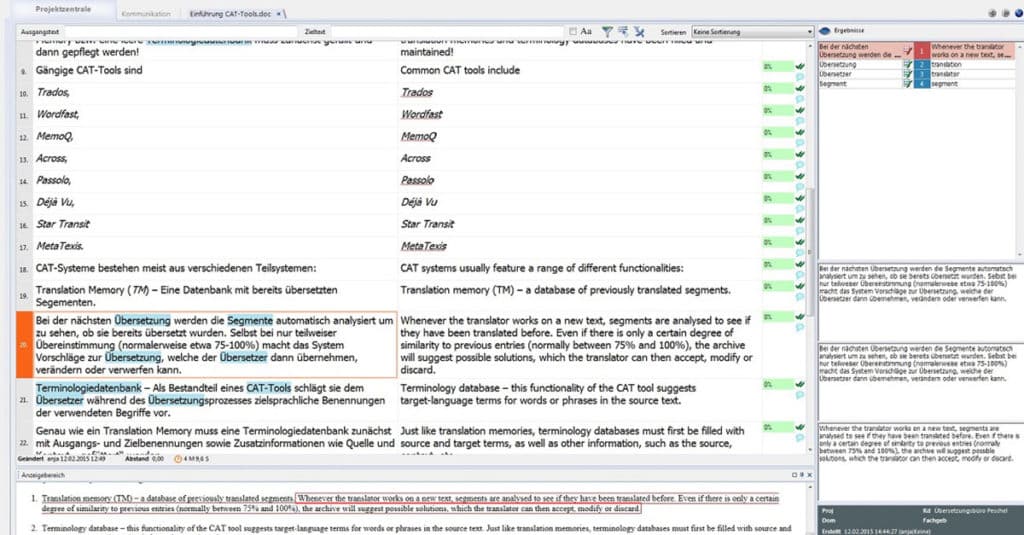
One of the computer-assisted translation advantages is that it enables translators to work efficiently and ensure that every translation project delivers consistent, high-quality output across multiple target languages.
Key takeaway: CAT tools are the backbone of the modern translation services, providing the infrastructure that makes large-scale multilingual communication possible.
When translation leaders evaluate new technology, they’re not just chasing efficiency. They’re looking for ways to handle scale, guarantee consistency across target languages, reduce costs, and give project managers oversight in increasingly complex translation projects.
The real power of computer-assisted translation tools lies in how they deliver on these fronts simultaneously. Below, we break down the five most important computer-assisted translation advantages.
A CAT tool’s job is to eliminate wasted effort.
One of the most immediate computer-assisted translation advantages is raw productivity. By reusing translation memory segments and surfacing fuzzy matches, CAT tools cut down repetitive work. Instead of retranslating boilerplate sections, translators can focus energy on new, high-value content.
The real advantage here is compounding. The more a team uses CAT tools, the larger and richer the translation memory becomes, feeding future projects and accelerating turnaround times. For businesses under constant pressure to shorten release cycles, this isn’t just helpful—it’s transformative.
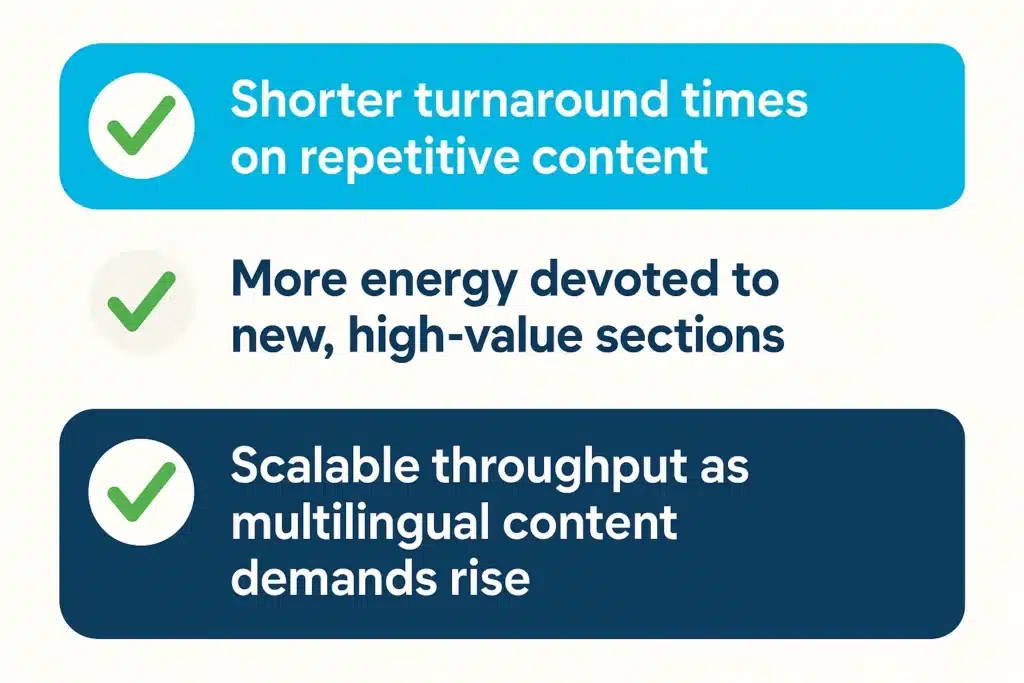
For enterprises in regulated industries—medical devices, pharmaceuticals, finance—the margin for inconsistency is nonexistent. CAT tools embed terminology databases, glossaries, and style guides that enforce preferred terms across all translated content. Style guides and linguistic rules can be hard-coded into the environment, ensuring consistent brand voice and compliance.
This ensures consistent translation across multiple target languages, no matter how many translators are working on the project. One of the most overlooked advantages of computer-assisted translation is how seamlessly it handles document translation, but perhaps the most critical when compliance and brand trust are on the line.
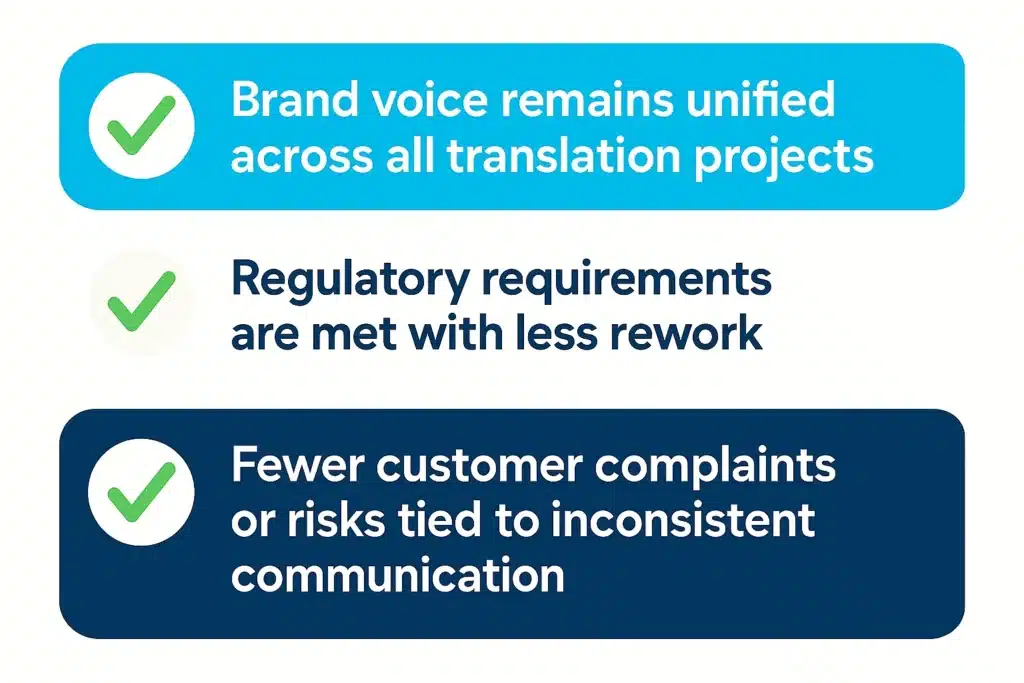
Translation isn’t cheap. But with computer-assisted translation CAT environments, costs become more predictable.
This means reducing the volume of new content that requires full-price human translation. With translation memory (TM), repeated or partially repeated content is billed at reduced rates—or handled internally at lower effort.
For in-house teams, this means predictable cost savings over time. The more translation projects flow through the CAT environment, the greater the long-term financial return. It transforms translation memories into a genuine business asset rather than just a linguistic by-product.
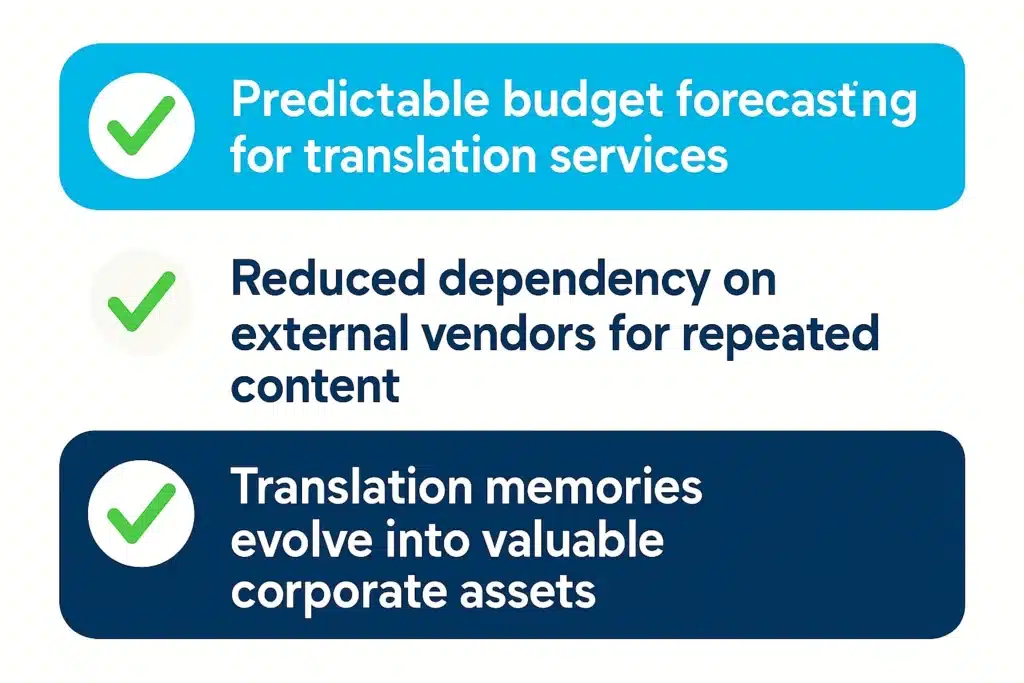
Human reviewers catch errors, but they’re not infallible. Even the best human translators can miss a misplaced number, a forgotten unit, or a mismatched tag. CAT tools embed automated quality assurance modules that scan content for errors before delivery. These checks cover terminology consistency, numbers, formatting, and untranslated segments. They flag when punctuation in the target language doesn’t align with standards.
This doesn’t replace human QA. It augments it. By catching low-level errors automatically, CAT tools allow human reviewers to focus on meaning, nuance, and cultural resonance. This dual layer elevates the overall quality of translated content while reducing rework.
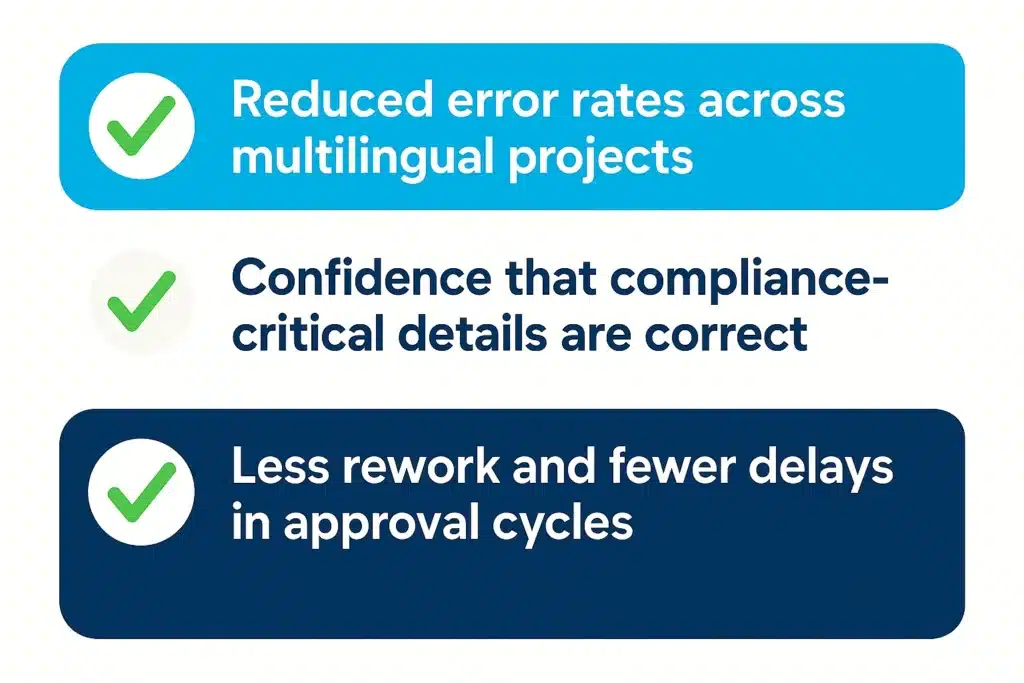
Modern translation rarely happens in isolation. Large organizations manage dozens of translators, editors, and subject matter experts spread across time zones. Assisted translation CAT tools create shared workspaces where everyone accesses the same translation memory, terminology, and project files.
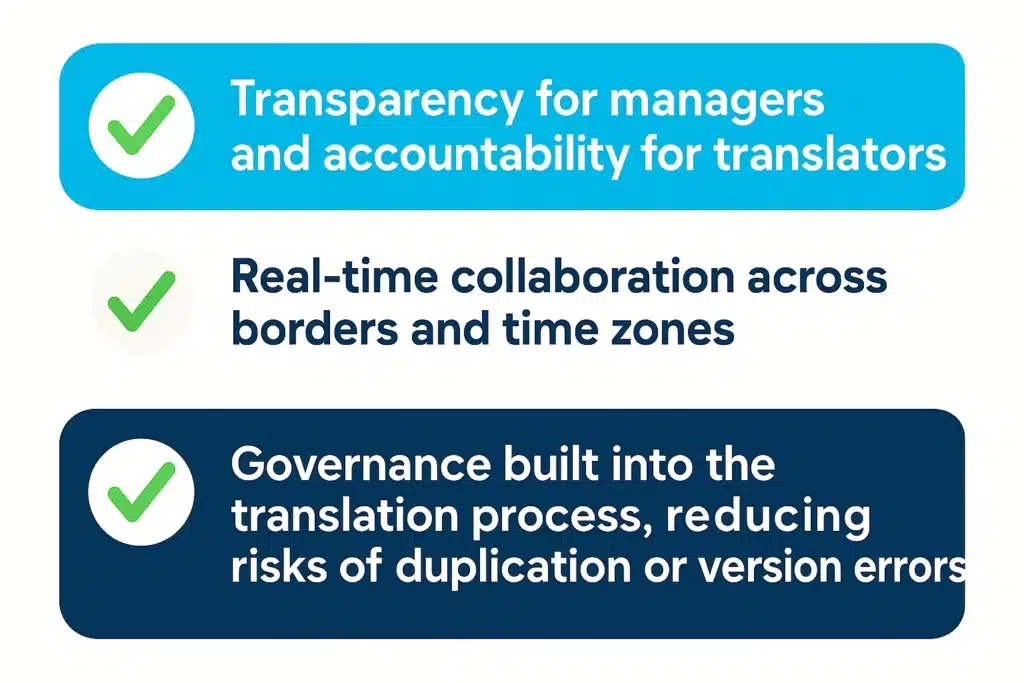
The narrative of “CAT vs. AI” misses the bigger picture.
Translation leaders no longer choose between computer-assisted translation tools and machine translation—they decide how to combine them strategically. In practice, CAT tools provide the structure, and AI provides the scale. The synergy lies in using AI to accelerate output while CAT tools ensure the results remain consistent, compliant, and contextually correct.
The real story is integration.
Where the Blend Adds Real Value
Key takeaway: CAT tools and AI are not competing technologies—they are complementary layers of the modern translation process. Together, they give project managers governance, enable translators to focus on quality, and allow businesses to deliver multilingual content at the speed of global demand.
No technology is flawless. While the advantages and disadvantages of computer assisted translation are often debated, the key is knowing when the strengths outweigh the weaknesses.
| Advantages of Computer Assisted Translation | Disadvantages of Computer Assisted Translation |
| Efficiency – Translation memories (TM) and fuzzy matches accelerate repetitive projects. | Learning Curve – Translators may need time and training to use CAT environments effectively. |
| Consistency – Glossaries, QA checks, and terminology enforcement ensure consistent translation across target languages. | Licensing Costs – Enterprise CAT tools require upfront investment and ongoing subscriptions. |
| Cost Savings – Reuse of translated content reduces costs over time, making TMs long-term assets. | Creativity Limitations – Segmentation can disrupt natural flow in creative marketing content. |
| Scalability – CAT tools enable translators and project managers to manage complex translation projects across multiple markets. | Maintenance Needs – Translation memories and term bases require ongoing updates to avoid outdated entries. |
The Balanced View
When considering computer-assisted translation advantages and disadvantages, in-house teams should map these factors against their content needs. For repetitive, compliance-driven, or large-scale projects, the advantages far outweigh the limitations. For one-off creative marketing campaigns, manual workflows may still be preferable.
Conclusion: From Optional to Critical Infrastructure
The case for CAT tools is no longer about experimenting with technology. It’s about operational necessity. Computer-assisted translation advantages are tangible—faster turnaround times, cost savings, consistent multilingual output, and transparency for project managers. Translation memories, glossaries, and QA modules are not just linguistic tools; they are business infrastructure.
For in-house teams under pressure to deliver accurate, compliant, and multilingual translated content at scale, computer-assisted translation advantages shift the question from if to how fast can we adopt them. Those who hesitate risk inefficiency, inconsistency, and rising costs. Those who act position translation not as a bottleneck, but as a competitive edge.
FAQs:
1. What is Computer-Assisted Translation?
Computer-assisted translation (CAT) is the use of software to support human translators in producing accurate and consistent multilingual content. Instead of replacing translators, CAT tools provide memory databases, terminology checks, and quality assurance features that make the translation process faster, more reliable, and scalable.
2. What are CAT Tools?
CAT tools are specialized applications that serve as the translator’s workspace. They store past translations in a translation memory, suggest fuzzy matches for similar content, enforce terminology rules, and handle multiple file formats.
3. How Does Computer-Assisted Translation Work?
The process begins by importing content into a CAT tool, which breaks it into segments. Each segment is checked against the translation memory, and matches or machine translation drafts appear for review. Translators then refine the output, apply terminology rules, and run automated QA checks before exporting the final translated content in its original format.
Big numbers, lots of documents and multiple translations?
Our top performing teams deliver unmatched quality on time for you
to hit your business goals.
Ready to burst your borders and need work done quickly?
Order Now! To get an instant assessment and quote.
Don’t wait, we’re ready.
SAVE TIME & MONEY!
Order from our mobile app now